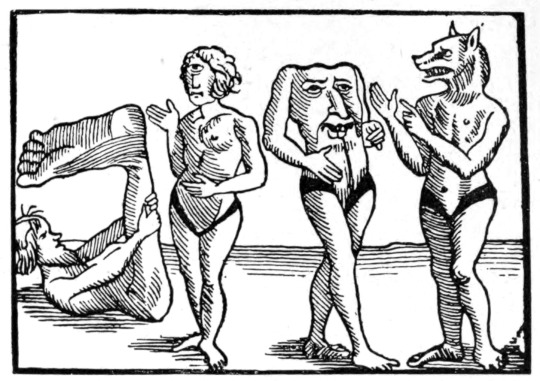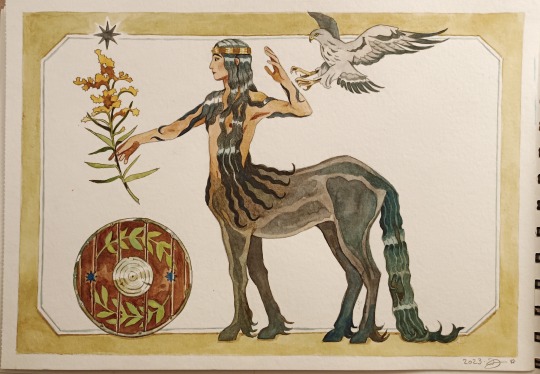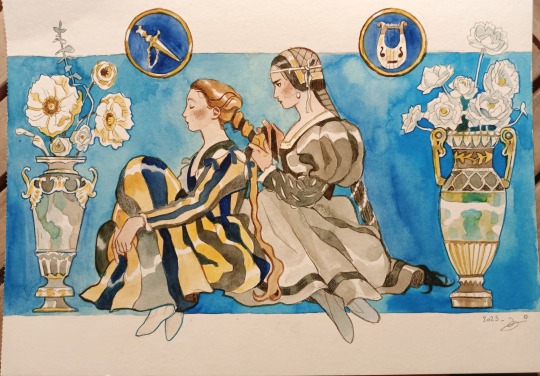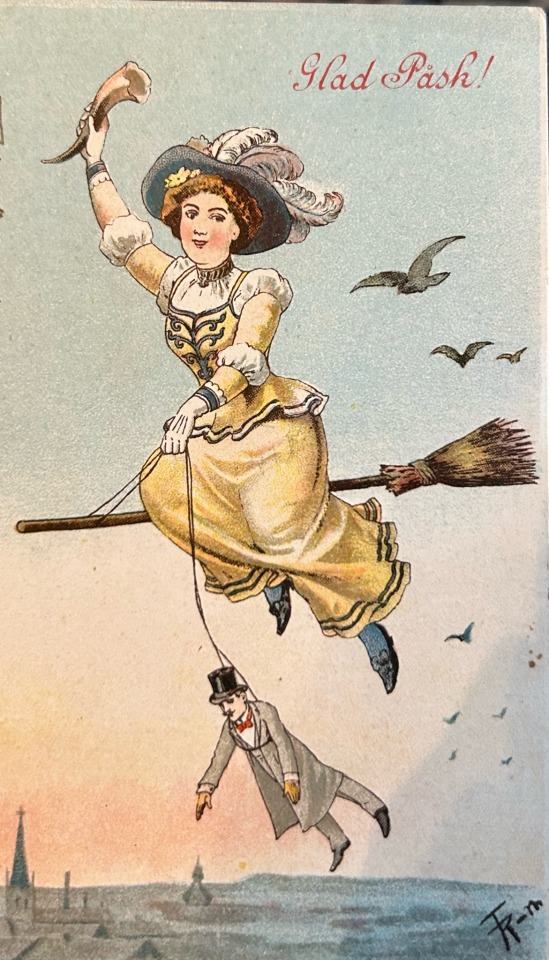#folklore thursday
Explore tagged Tumblr posts
Text
Werewolf Fact #75 - Cynocephali (dog-headed men)
This month's folklore fact is a long-awaited one from over on the Patreon: the cynocephali or "dog-headed men."

Some depictions of cynocephali (the one above is from the Nuremberg Chronicle, 1493) are mistaken for werewolves fairly frequently; there are several differences of note, including but not limited to the fact that they are otherwise very, very human (normal hands and feet, no tail, etc) and that their ears are not always shaped like a wolf's/pointing directly upright. They often are, however, so don't take the ear shape as a surefire thing, either. When in doubt, make sure the depiction is actually meant to be showing a werewolf before using it for, I don't know, a royalty-free image in your werewolf publication (I've seen several). The cynocephali do not shapeshift, nor are they associated with wolves. They have nothing to do with werewolves. Yes, it was just a plot to make you click this link and read about cynocephali.
Cynocephali, or singular cynocephalus, is a term derived from the original Greek word "kynokephaloi," meaning "dog-headed." They have other names as well, which mean a range of things such as "dog-faced" and "half-dog." They were mentioned in assorted accounts and tales of travelers in Africa and India, appearing in sources as old as ancient Greece, and some similar beings can be found in other cultures, such as China. Likewise, depictions of and discussions of such beings continue into the Middle Ages. This same term was later used to refer to baboons, to which no-fun modern day scholars now attribute all cynocephali legends (although we do have at least one Ottoman depiction of a cynocephalus battling a monkey).
There are many quotes across various sources and time periods about these beings, including but not limited to this one from the fifth century BC Greek historian Herodotus, Histories 4. 191. 3 (trans. Godley) [source: Theoi]
"For the eastern region of Libya, which the Nomads inhabit, is low-lying and sandy as far as the Triton river; but the land west of this, where the farmers live, is exceedingly mountainous and wooded and full of wild beasts. In that country are the huge snakes and the lions, and the elephants and bears and asps, the horned asses, the Kunokephaloi (Cynocephali) (Dog-Headed) and the Headless Men that have their eyes in their chests, as the Libyans say, and the wild men and women, besides many other creatures not fabulous."
Some stories of the cynocephali are also frightfully specific as to how they live, rear livestock, grow fruit, weave baskets, wage war, and much more, even including details of their society, clothing, how long they live, etc. It's all quite interesting. If you'd like to read more specific quotations, you can find many on one of my favorite websites, Theoi.
Sources seem to dispute one another as to whether they bark, do not bark but only howl, only shriek, or whatever other sounds they may make, and there is also a range of descriptions including elements such as if they have beards and whether hair covers their bodies as well as the dog-head. Overall, probably the majority of sources say they wear the skins of animals as opposed to having fur, but there are those that also call them hairy all over.
Please note that I will not be covering/discussing any gods from ancient Egypt in this post, because despite what some modern day scholars like to discuss, I don't consider them "cynocephali." They were wolf-headed deities, not dog-headed (or even jackal-headed), and are overall only related to cynocephali legends by proxy and by modern scholars always putting everything into blasted categories for their next thesis. There were some dog-headed deities in ancient Egypt, and Anubis, Wepwawet, Duamutef, etc, were not among them, and even then, we can't really assert that the dog-headed deities among the ancient Egyptians are actually related to other legends and records of cynocephali.
With that out of the way, let's continue...

One of my personal favorite stories involving a dog-headed man is a version of the tale of Saint Christopher, though these depictions and this tale are not seen as canon by churches and has been proscribed in Eastern Orthodoxy (where such depictions were generally most common). Some of these depictions still survive, however. Some sources believe that Byzantine depictions of a dog-headed Christopher come from mistaking "Cananeus" (meaning "Canaanite") for "caninus," i.e. canine.
In the story about a dog-headed Saint Christopher, there lives Reprebrus (among other variations of his name; ultimately, they all essentially mean "reprobate"), who is captured by Romans in battle and made to serve among them. Reprebrus was said to be of "enormous size," with the head of a dog, said to be typical of his kind. He was later baptized and martyred. However, in another version (this one from Germany), Saint Christopher is depicted as a giant cynocephalus who ate human flesh and performed many atrocities. He meets the Christ child later and carries him across a river, as in tradition (the name Christopher means "bearer of Christ") and repents for his sinful behavior. He is baptized and becomes human, dedicating himself to serving Christianity and became a soldier saint.
There are far more fascinating details in the story than I relayed here in extreme simplicity, but that's a very simple view (the story is actually very specific about different regions and even the unit in which he served).
Other depictions of cynocephali exist in certain Christian traditions, with Ahrakas and Augani sometimes being depicted with dog heads in Coptic Christian tradition, in the life and legend of Saint Mercurius.

Bestiaries also got pretty wild with the creatures depicted therein, many of which were also mentioned in classical sources (such as the Herodotus quote earlier in this post). The image above is from between 1357 and 1371, in a work called The Voyage and Travels of Sir John Mandeville, or simply Mandeville's Travels, the memoirs of a man who traveled across the Middle East, India, and even as far as China. Medieval bestiaries also recorded all the same creatures shown here: a monopod or sciapod, a cyclops, a blemmy, and a cynocephalus, each different civilizations of beings said to dwell across the world (and often cited in multiple sources over considerable spans of time, which generally cite the same or similar regions for each civilization, which I've always found very interesting).
Mentions of the cynocephali span across centuries, such as in works by scribe Paul the Deacon, a Benedictine monk, and they are even mentioned in the Nowell Codex, a surviving Old English work containing Beowulf (as well as a work of the life of Saint Christopher and Wonders of the East, among others). They are also acknowledged in the works of multiple noteworthy explorers, including but not limited to Marco Polo, Christopher Columbus, Giovanni da Pian del Carpine, Ibn Battuta, and Piri Reis.
With that, I think that's a decent overview! Hope you enjoyed the post.
And stay tuned for news and updates on a major [werewolf/fantasy/adventure/horror/epic] book release later this year!
If you like my blog, be sure to follow me here and elsewhere for much more folklore and fiction, including books, especially on werewolves! You can also sign up for my free newsletter for monthly werewolf/vampire/folklore facts, a free story, book previews, and my other sundry projects and works, such as plushes.
Free Newsletter - maverickwerewolf.com (personal site + book shop + free fiction) — Patreon — Wulfgard — Werewolf Fact Masterlist — X — Vampire Fact Masterlist — Amazon Author page
#folklore#mythology#dog-headed men#dog heads#cynocephalus#cynocephali#dog man#fantasy creature#folklore fact#folklore thursday#myth#history#fantasy#werewolf#werewolves#not actually werewolves but people mix them up a lot#a werewolf has to shapeshift to be a werewolf#also these are dog-headed men not wolf-headed men#but anyway#research
77 notes
·
View notes
Text

6 notes
·
View notes
Text
Stan Rogers singing The Witch of the Westmoreland.
And Malinky performing The Twa Sisters.


Two little paintings : The Witch of the West-Mer-Lands, and the Twa Sisters
#folklore#child ballads#roud song index#folklore thursday#on saturday#art#folk music#stan rogers#ballads
9K notes
·
View notes
Text

The Headless Dandy, the headless ghost of a man who was decapitated by his lover's jealous husband. Inspired by a story retold by S.E. Schlosser in her book Spooky California (2019).
Something I made last weekend; decided to wait until today to post it, in light of the Folklore Thursday hashtag that I see on social media.
#headless dandy#spooky california#se schlosser#ghost story#american folklore#folklore thursday#my art#digital art#procreate
1 note
·
View note
Text



Our new exhibit Falcon Frights provides an overview of the ghosts that have haunted Wood County. The university has famously housed the Chi Omega house ghost Amanda, as well as theater ghost Alice, who reportedly haunted the old University Hall Saint and Brown theaters. Beyond the university's hallowed halls, the exhibit explores other famous local haunts such as Crybaby Lane, Holcomb Woods, Nazareth Hall, and Mary Bach's famous fingers. Come check out our local lore! Scan the QR code in the last picture to listen to a podcast about local ghost lore produced by Department of History grad students!
1 note
·
View note
Text
Fandoms Art History
I am so genuinely fascinated by the trends of fanart styles and how other fandoms/artists can leave such a significant impact on other fandoms/artists. I’m taking art history classes rn in college, and while taking notes about how everything has its influences (especially religious), I am left struck with how significant of an art history fandoms have. Please I need to know if anyone has thoughts on this and have any comprehensive guide on fanart style trends over the years?? I only know a little based on my experience, but I’ve noticed a general shift in the preferred style of some areas I’m in (all very fascinating!)
(also recognizing that each fandom has its own history and influences on top of fandoms as a collective and how they interact.
And I can’t be convinced that religious art being so dominant throughout human history hasn’t translated into how fandoms behave and also make art, lore, and communities)
#Anyways time for me to go to bed! Just your normal average thoughts on a Thursday night :3#this post is an excuse for anyone to ramble don’t feel bad about leaving thoughts pls I’m very curious#I’ve noticed a trend of more anime influence changing to the Hamilton squishy style to a more…#how do I describe it? Naturalistic? Folklore?#but I’m not in every fandom and this doesn’t apply to every artist and community#Don’t know how many people may comment but do keep it respectful if you do#art stuff
8 notes
·
View notes
Text

Sfânta Joi, lady of marrying opposites.
Half woman, half man; with a foot in winter and one in summer, both a protector and harsh punisher, patron of spinning, weaving and needlework who forbids those activities on her holliest days, Joi(Thursday) ties together the week and most likely, given how many important Thursdays without christian connections are in the traditional calendar, used to be the queen of the week. The middle of the week carried a lot of power in the old days, being associated with the full power of the Sun. With the rise of Christianity that power was divided between Joi and Duminică(Sunday), the latter gaining the positive gentle light and fertile warmth, and Joi keeping the scorching heat. Still, there was no full usurpation; the two ladies share the center of the sky for a home and Joi still presides over the transition between seasons and remains the luckiest day of the week when it's great to be born, get engagged and married. Usually it is a day free to any kind of labor, exept in the transition period between winter and summer and vice versa, when it is forbbiden to spin thread, weave or sow on Thursday. On the Thursday before Easter, it is said that Joimărița visits every household to inspect the hardwork, skill and creativity of women, burning the fingers of those who have not finished spinning last year's flax and leaving gifts for those who finished their work, the prettier their new clothes they made the more luck they'll have over the year.
#Joi#thursday#romanisme#romanian mythology#romanian folklore#myth#mythology#folklore#illustration#drawing#ink#pen and ink#art#artists on tumblr
43 notes
·
View notes
Text
Happy Witch Gentleman Shibari to all those who celebrate!

#I’m a little late#day of the witches#easter#swedish folklore#Maundy Thursday#Easter witches#Easter postcards#vintage postcards#Vintage Easter Cards#Blåkulla
7 notes
·
View notes
Text
Inspired by @swiftpolls posts from a couple of weeks ago (I think) except I'm doing 12 instead of 10 bc I can :D
#why not have a top 12 its a fun number#taylor swift#polls#ts polls#taylor swift polls#taylor swift debut#ellies polls#i am still doing TSvTS btw the folklore vs evermore is queued for Thursday morning
4 notes
·
View notes
Text

I'm sooooooooooo
#high listening to folklore and thinking about them#a typical Thursday night#anyways#jancy#jonathan byers#nancy wheeler#Spotify
13 notes
·
View notes
Text

For Throwback Thursday, here is one of the first pieces I ever wrote after creating "Retro Revelations", all the way back in October of 2012. My favorite childhood "toy", the incredible Monster in my Pocket figures!
#monster in my pocket#90s#toys#monsters#mythology#folklore#throwback thursday#nes#konami#figures#collectibles#GOAT#Retro Revelations#Halloween
9 notes
·
View notes
Text
Folklore Fact - Wargs (or vargs or worgs)
Wargs (aka worgs, if you play D&D) handily won the poll for August's folklore fact. What are these giant wolves like, anyway, and are they really all evil in legend?

The jötunn Hyrrokin riding a wolf, on an image stone from the Hunnestad Monument, constructed in 985–1035 AD
As usual, let's start with etymology. The word “warg” comes from Old Norse “vargr” (plural “vargar”), meaning - essentially - "destroyer." Originally, the term is thought to have meant "wolf," but over time, it shifted to refer to criminals (with an inherent negative meaning) instead. Thanks particularly to Tolkien, it is now widely used in scholarship to refer to the various giant wolves of Norse mythology, such as perhaps the mightiest and most terrifying monster in Norse myth, Fenrir (destined to swallow Odin during Ragnarok), along with Skoll (destined to swallow the sun) and Hati (destined to swallow the moon).
Note that this was not the common Old Norse word for wolf. "Varg" came to have a specifically negative connotation, whereas "ulf" (meaning simply "wolf") did not.
There were also plenty of other wargs/giant wolves in Norse myth, often being used as mounts to various gods and giants and other extremely powerful individuals; they were particularly favored of the jötnar, who, despite the simplification in a lot of modern media, were not always universally malevolent and hostile toward the gods. The runestone seen above depicts the giantess Hyrrokin who arrived to assist the gods with shoving off Baldr's funerary ship during Baldr's funeral, as no one else could move the vessel. She arrived riding on the back of a huge wolf so mighty that, after the giantess dismounted, even Odin's berserkers could not restrain it until it was knocked unconscious.
Does this also make Odin’s wolves, Geri and Freki, "wargs" in the modern scholarly concept? That was never really specified. But they are giant, godly wolves, perhaps meant to be the fathers of all wolves everywhere, so… Maybe? In some tales, during Odin's wanderings, Geri and Freki spread their wolf offspring across the world. Thus, it is possible they are simply giant godly wolves rather than specifically "wargs," but it's also possible that mythology wasn't ever planning to be that nitpicky and specific. Odin was, of course, also the creator of the berserkers, which gives him yet another wolf connection.
Going back to etymology for a moment, "ulf" was frequently incorporated into personal names. Wolves were not seen as wholly undesirable in Norse culture; to claim wolves were always seen as "evil" or somehow "negative" is to simplify the concept beyond belief. Wolves were admired for their fabled ferocity, endurance, will to live, voracity, and prowess in battle. Thus, wolves became a symbol of strength and a desirable image for great warriors. Though often feared, this fear is precisely what led many warriors to desire to be like a wolf, for they too desired ferocity feared by those around them. Wolves were a force of nature, an uncontrollable power to be respected (such as the power of the berserkers, again, who themselves were associated with wolves and, despite their connections with the god Odin, were also at once frequently seen as undesirable but worthy of respect), not simply a force of black and white "pure evil." How terrifying they were led to wolves becoming arguably the most powerful and feared monsters in Norse myth, but likewise, it was an image their warriors often wanted to take up and present.
While the majority of named giant wolves from Norse myth are certainly evil, such as Fenrir, what truly popularized the modern concept of the evil wargs in popular culture was - of course - the father of all fantasy and unmatched scholar JRR Tolkien. Likewise, Tolkien popularized the idea of goblins and/or orcs riding giant wolves into battle, no doubt inspired by the jötnar of Norse myth. Obviously, Norse and other myths greatly inspired many elements of The Lord of the Rings. Wargs are no different, but he did of course put his own interpretation upon them - an interpretation that has, like so many of his creations, become staples of many fantasy settings and even the popular mindset.
Whereas wargs in myth are at least semi-divine mounts of gods and giants, the wargs by the Third Age of The Lord of the Rings are mounts for goblins and their ilk. However, the wargs are intelligent and even have a sort of language, one some beings (such as Gandalf, notably inspired to no small degree by elements of Odin, himself) can understand, even if it is an evil tongue and they use it to speak only of evil things, as seen in The Hobbit. In the books, the wargs are often associated with Tolkien's very unfortunate portrayal of werewolves. I won't get into all the details of that. I adore Tolkien and all his works beyond my love for virtually anything else, but I cannot say I love his portrayal of "werewolves," though I do understand them.
So where then do we get this spelling of "worg?" That's entirely Dungeons and Dragons. Oldschool D&D wholesale ripped off Tolkien - which is one reason why oldschool D&D is so great - and had to change some of the terms they used. Balrog became balor, hobbit became halfling, mithril became mithral, etc. The same applies to "warg," Tolkien's term, which became "worg" in Dungeons & Dragons.
So where does this leave A Song of Ice and Fire aka Game of Thrones, with the "wargs" that are "skinwalkers" who can "warg" (verb) into animals, etc, and see through their eyes? There were plenty of legends out there - from Norse myth and otherwise - wherein people could project their consciousness into the bodies of animals when they slept or otherwise entered a kind of trance (some legends that could be considered werewolves also worked this way), but the term "warg" was never used to refer to such acts.
Ultimately, the modern concept of wargs is yet another major fantasy element that Tolkien alone conceptualized into what it is now in broader popular culture. Yes, it is certainly based on Norse myth, but Tolkien is the one who gave us our popular concepts of them today.
That's it for a general overview! This is a vast topic into which I could delve far deeper, but now you should have some general idea.
If you like my blog, be sure to follow me here and elsewhere for much more folklore and fiction, including books, especially on werewolves! You can also sign up for my free newsletter for monthly werewolf/vampire/folklore facts, a free story, book previews, and my other sundry upcoming projects and works, such as plushes (including all your werewolf and wolf and mythology plush desires). Please also consider supporting me over on Patreon (link at bottom of post); I promise you'll get awesome rewards in return, and every little bit really does help me continue my work.
And stay tuned for news and updates on a major [character-driven werewolf/fantasy/adventure/horror/semi-epic] book release coming THIS NOVEMBER!
Free Newsletter - maverickwerewolf.com (personal site + shop + free fiction) — Patreon — Wulfgard — Werewolf Fact Masterlist — X — Vampire Fact Masterlist — Amazon Author page
#warg#wargs#varg#vargs#worg#worgs#folklore#folklore fact#mythology#norse mythology#norse myth#history#wolf#wolves#resources#research#monsters#creatures#myth#dungeons and dragons#game of thrones#tolkien#lord of the rings#the hobbit#ragnarok#fenrir#fenris#werewolf wednesday#werewolfwednesday#folklore thursday
53 notes
·
View notes
Text
This Week's Snippet Schedule:
Late, because this Monday was more Monday than usual 😵💫
Anyway, I'm between two or three choices so guess what, it's Poll Time again!
#fic prompts#writing prompts#prompt schedule#snippet schedule#polls#free day thursday#folklore friday#final fantasy friday#meddling mar au#legend of zelda#ff xv#i have a whole 'Ardyn Is Trying To Drive Niflheim Mad' au made entirely of snippets#in which Ardyn is secretly a Knight of Etro a la FF XIII-2
12 notes
·
View notes
Note
Hello! 7 in the ask game!
Hey hey! Hope you’re doing good!
Oh fuck this is hard! Esp hard to do this tipsy bahahahahah. My bronze knife ( there’s some pics of it on my blog ) I’m very fond of. My rings. A fossil stone from the coast, hagstone, I have a triad of river pebbles I use a lot! ( green white and red ). I think my all time favorite tool was a vessel I constructed from local clay used for the land spirits, it was destroyed and returned to the stream when I moved.
Oh! My stangs! One is from the coast- the same island I found my hagstone and fossil stone. The other from the property I used to live on. Both are very very dear to me for different reasons. I find them to be equally practical and esoteric.
Poetry is so nice for expressing things I either can’t, for whatever reason, explicitly talk about, or spiritual experiences I can’t adequately express otherwise.
#asks#ask game#traditional witchcraft#magic#tradcraft#occult#folk magic#magick#witch#witchcraft#folklore#traditional craft#I had a lot of wine#too much really#yes I know it’s Thursday
3 notes
·
View notes
Text
monday = fearless
tuesday = speak now
wednesday = red (with the comeback on the last poll, wow)
#i feel semi strongly about this one#but we'll see what others think#polls#taylor swift#taylor nation#debut#1989#repuation#lover#folklore#evermore#midnights#eras tour#my polls#tumblr polls#thursday
2 notes
·
View notes
Text
Day 5 of Hotsui Matsuri: The Beauty of Natsume Yuujinchou
Here's a brief summary of why Natsume Yuujinchou is a beautiful, beautiful anime. #anime #anitwt #hotsuimatsuri #natsumeyuujinchou
It’s either your calming cup of tea or the most boring show you’ve ever seen. It paints gorgeous sceneries, touches on ancient mythologies, and crafts soothing and beautiful OSTs. The show is honestly one of my favorites, and it’s perfect for Hotsui Matsuri. Natsume Yuujinchou, or better known as Natsume’s Book of Friends is a slice-of-life anime/manga about an orphan boy who inherited a book…

View On WordPress
#aniblogger#anime#anime review#cup of tea anime#feel good anime#hotsui matsuri#Japanese folklore#Japanese Mythology#Madara#manga#Natsume#natsume yuujinchou#natsume&039;s book of friends#nyanko-sensei#otaku#otkaku thursday#slice-of-life anime#Takashi Natsume#weeaboo#weeb#what to watch#yokai
5 notes
·
View notes